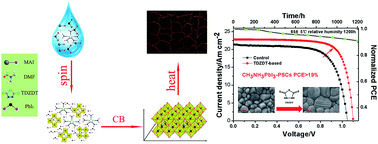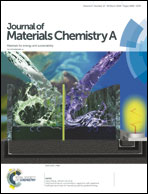Suppressing defects through thiadiazole derivatives that modulate CH3NH3PbI3 crystal growth for highly stable perovskite solar cells under dark conditions†
Abstract
The stability of perovskite solar cells is still one issue that needs to be solved, though remarkable success has been achieved since its first report in 2009. In this work, two thiadiazole derivatives (1,3,4-thiadiazolidine-2-thione, TDZT and 1,3,4-thiadiazolidine-2,5-dithione, TDZDT) were added into a perovskite precursor to modulate CH3NH3PbI3 perovskite crystal growth. Thiadiazole derivatives can allow the size of the CH3NH3PbI3 crystals to exceed 800 nm and can reduce the grain boundaries. The defect density, calculated using the space charge limited current (SCLC) method for perovskite, was 7 times lower when a certain amount of TDZDT was added. As a result, we obtained a power conversion efficiency (PCE) of 19.04% accompanied by excellent stability under humidity and heat. The unsealed devices retained 91.2% of their initial PCE after 1200 h in 65 ± 5% relative humidity at room temperature under dark conditions, and over 90% of their initial PCE after 840 h of aging in 30% relative humidity and ambient air at 60–75 °C under dark conditions. The result showed that these thiadiazole derivatives can effectively suppress the defects, thus improving the efficiency and stability of the perovskite solar cells.



 Please wait while we load your content...
Please wait while we load your content...